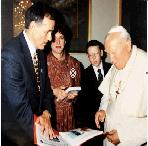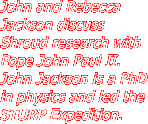John and research team member Keith Propp, physicist, construct Shroud model for testing. |
||
John working at computer on algorithms that map folds on Shroud to Constantinope device: Man of Sorrows Icon. |
||
Radiocarbon contamination Experimental apparatus |
||
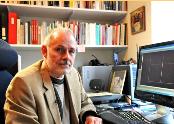
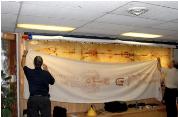
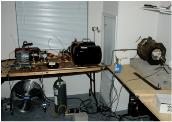
Research
The Turin Shroud Center of Colorado (TSC) is dedicated to conducting multi-disciplinary historic and scientific research on the Shroud. Our research efforts are currently dedicated to the following nine areas inquiry:
- Scientific investigation of how the image was formed on the Shroud.
- Scientific investigation of the hypothesis that some method of binding enriched C-14 carbon monoxide into the Shroud was responsible for an erroneous radiocarbon dating of the Shroud to the 14th century. We know that the radiocarbon date conflicts with historic data that takes the Shroud much further back in time. Nevertheless, TSC needs to attempt to comprehend why the dating was apparently in error.
- Scholarly studies of the Shroud in light of the first century Jewish/Roman world.
- Accelerated aging characteristics of linen when exposed to radiation.
- Studies of the Shroud in Constantinople during the Middle Byzantine Period.
- General scholarly investigation connecting the Shroud to early Liturgical, and Iconographic foundations.
- Investigation of the hypothesis that the Shroud was historically part of the Tablecloth of the Last Supper before it was used as the burial Shroud of Jesus.
- Scientific and scholarly studies of the Shroud and its relation to the tradition of the Triduum (i.e. Holy Thursday, Good Friday, Easter Sunday), and the early Church.
- Scientific studies of the Sudarium of Oviedo in Oviedo, Spain as possibly the "cloth that had been on Jesus' head, not lying with the linen wrappings but rolled up in a place by itself", mentioned in the Gospel of John (John 20:7).

